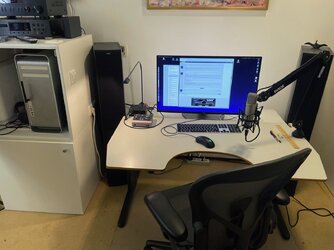Baronicle
Registered
Thread Starter
- Joined
- Feb 5, 2024
- Messages
- 10
More
- Preamp, Processor or Receiver
- Schiit Magni headphone preamplifier
- Main Amp
- Yamaha R-N301
- Computer Audio
- Mac Pro Soundcard is NOT USED: Only Digital Processing
- DAC
- Schiit DAC Modi box
- Universal / Blu-ray / CD Player
- Mac Pro 5,1 built in CD and Blu-ray drives
- Front Speakers
- Jamo S629
- Subwoofers
- Built in to the Jamo (one on each channel)
- Video Display Device
- Radeon RX 6800
- Screen
- Dell G3223Q Gamers Computer Monitor
- Other Equipment
- Mac Pro Tower Computer macOS 12.7.3 Monterey
I have been watching YouTube guides on how to use REW, but these have not been helpful. To calibrate my sound-card I am instructed to connect the output of my interface to the input of my interface. What interfaces? This is wholly unclear to me.
I have a Mac Pro 5,1 Tower computer running Monterey macOS 12.7.3. However, I do not use the sound-card on my computer, but have peripheral devices for DAC and ADC, as follows:
INPUT: I use the RODE NT1-A microphone to that goes via balanced cable to the Audient iD4 mixer, a USB device. I have calibrations files for this microphone.
OUTPUT: I use the digital optical output to a Schiit DAC Modi box, connected directly to the Schiit Magni headphone preamplifier, which in turn is connected to the AUX input on the Yamaha R-N301 Stereo amplifier, that is driving Jamo S629 HiFi speakers. These speakers have subwoofers on each channel.
This system bypasses the Apple Mac Pro built-in sound card. The Mac Pro is used only for digital processing of audio files.
What must I connect to what in order to make the "sound-card" (peripheral devices) calibration file?
I have a Mac Pro 5,1 Tower computer running Monterey macOS 12.7.3. However, I do not use the sound-card on my computer, but have peripheral devices for DAC and ADC, as follows:
INPUT: I use the RODE NT1-A microphone to that goes via balanced cable to the Audient iD4 mixer, a USB device. I have calibrations files for this microphone.
OUTPUT: I use the digital optical output to a Schiit DAC Modi box, connected directly to the Schiit Magni headphone preamplifier, which in turn is connected to the AUX input on the Yamaha R-N301 Stereo amplifier, that is driving Jamo S629 HiFi speakers. These speakers have subwoofers on each channel.
This system bypasses the Apple Mac Pro built-in sound card. The Mac Pro is used only for digital processing of audio files.
What must I connect to what in order to make the "sound-card" (peripheral devices) calibration file?
Attachments
Last edited:













